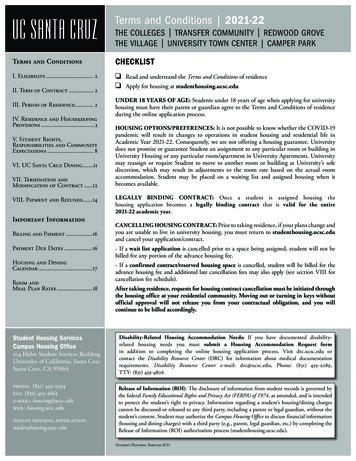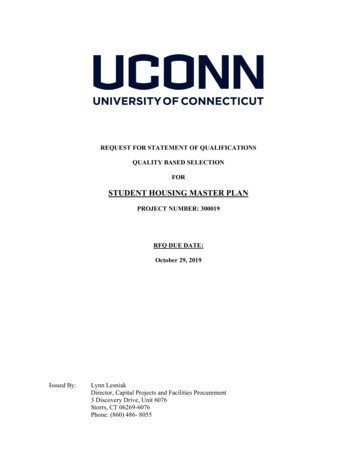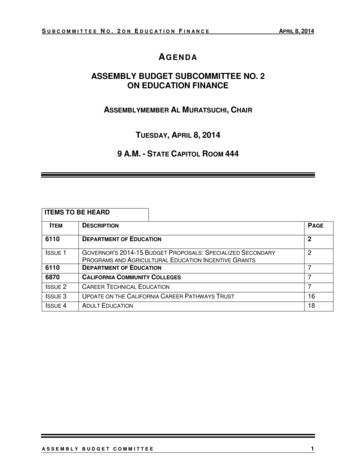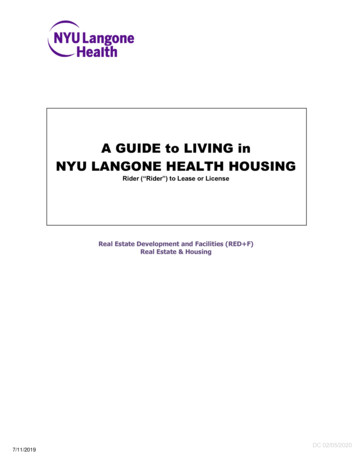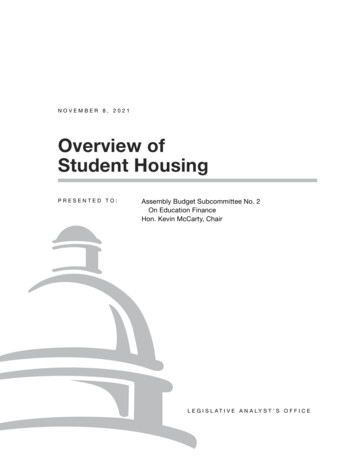
Transcription
NOVEMBER 8, 2021Overview ofStudent HousingPRESENTED TO:Assembly Budget Subcommittee No. 2On Education FinanceHon. Kevin McCarty, ChairL E G I S L AT I V E A N A LY S T ’ S O F F I C E
State Role Over TimeState Role Historically Has Been Small Historically, student housing facilities have been supported bystudent charges and have not been subsidized by the state. In 1987, the state provided the California State University (CSU)with 2.5 million one time to create a revolving loan fund availablefor campuses to add affordable student housing units. Under theprogram (which still operates), campuses can receive low-interestloans, which they repay over time using student housing charges.State Role Recently Was Expanded As part of the 2019-20 budget, the state created Rapid Rehousingprograms for homeless college students—providing total ongoingstate General Fund of 19 million ( 9 million for California CommunityColleges [CCC], 6.5 million for CSU, and 3.5 million for Universityof California [UC]). As part of the 2021-22 budget agreement, the state made its firstsubstantial contribution to student housing projects—providing stateGeneral Fund of 500 million in 2021-22, 750 million in 2022-23, and 750 million in 2023-24. Public community college and university campuses can apply forgrant funds to construct new student housing or convert commercialspace to student housing.New State Program Focuses on Capacity and Affordability Capacity. One goal of the new state program is to increase theinventory of student housing, particularly to help foster futureenrollment growth. Affordability. Another goal of the new program is to reduce the costof student housing, especially for lower-income students.L E G I S L A T I V E A N A LY S T ’ S O F F I C E1
Student Housing Goals: CapacityCapacity Goals Are Locally Driven State law does not contain specific student housing capacity goals.(State law does permit campuses to provide student housing, andit allows campuses to require students to live in campus housing.Under state law, all public campuses are to give current and formerhomeless youth and foster youth priority for any campus housing.) None of segments’ governing boards have established systemwidegoals for the share of students to be housed. Campuses set their own goals. Campus goals vary. Many campusesaim to house all interested first-year students. Some campusesaim to house first- and second-year students. In addition to singleundergraduate students, university campuses typically have goalsto house a certain share of graduate students and students withfamilies.Location of Campus Has a Big Impact A campus’ share of local versus nonlocal students has a majorimpact on the size of its housing program.—— Campuses with a high share of students commuting (includingcommunity colleges and some CSU campuses) tend to haveeither no on-campus housing or relatively small on-campushousing programs.—— Campuses with a high share of nonlocal students (includingUC campuses and some CSU campuses) tend to have largeron-campus housing programs.L E G I S L A T I V E A N A LY S T ’ S O F F I C E2
Existing Housing CapacityUniversity Campuses Have Added Considerable Housing Since2015 Since 2015, CSU reports having completed the construction ofapproximately 14,300 additional beds (through 28 campus housingprojects) and is in the process of constructing approximately 2,300additional beds (through 6 projects). UC reports having completed the construction of approximately21,700 additional beds (through 23 campus housing projects) and isin the process of constructing approximately 19,100 additional beds(through 21 projects).L E G I S L A T I V E A N A LY S T ’ S O F F I C E3
Graphic Sign OffSecretaryDeputyChief Dep.AnalystExisting Housing Capacity(Continued)LAO Report Large Template.ait ARTWORK #210561About Half of CSU Campuses and All UC CampusesHave Increased Student Housing CapacityStudent Housing Beds Added Since 2015San DiegoDavisIrvineRiversideUCLos AngelesMercedSanta BarbaraBerkeleySan FranciscoSanta CruzSan DiegoSan Luis ObispoSan FranciscoSacramentoLos AngelesChannel IslandsCSUBakersfieldMonterey BayDominguez HillsSan JoseLong BeachPomonaMaritime1,000L E G I S L A T I V E A N A LY S T ’ S O F F I C E2,0003,0004,0005,0006,0004
Graphic Sign OffSecretaryDeputyChief Dep.(Continued)AnalystExisting Housing CapacityLAO Report Large Template.ait ARTWORK #210561 At both CSU and UC, on-campus beds as a share of studentenrollment is slightly higher in 2020 compared to 2015.Housing Capacity Has Slightly OutpacedEnrollment GrowthOn-Campus Beds as a Share of 92020CCC Housing Is Mostly at Rural Colleges and Decades Old Prior to 2019, 11 community colleges had student housing programs.Almost all of these colleges were located in rural areas and hadlongstanding housing programs. In 2019, Orange Coast College opened a student housing facilitywith 800 beds. This student housing facility is the largest among thecommunity colleges (more than four times larger than at any other,accounting for about one-third of all community college beds in thesystem).L E G I S L A T I V E A N A LY S T ’ S O F F I C E5
Addressing and Responding toStudent Housing DemandCampuses Use a Similar Process to Assess Student HousingDemand Campuses routinely track on-campus occupancy rates, waitlists foron-campus housing units, and rental vacancy rates within their localareas. If waitlists for campus housing are high, local vacancy rates are low,and/or campus housing goals are not being met, campuses willinitiate a more intensive student housing study. As part of this study,campuses typically will survey students to learn more about theirhousing preferences as well as undertake a fuller analysis of the localhousing market.Many Campuses Currently Have Waitlists For fall 2021, CSU reports 13 campuses with waitlists totaling 8,700students (up from 5,800 in fall 2019). For fall 2021, eight UC campuses report waitlists totaling more than7,500 students. Some campuses report increases over pre-pandemiclevels, whereas others report substantial reductions.Many Campuses Have Plans to Further Increase HousingCapacity CSU reports 17 housing projects under development at 11 campusesadding more than 11,000 beds. UC reports 11 housing projects under development at 6 campusesadding more than 16,000 beds.L E G I S L A T I V E A N A LY S T ’ S O F F I C E6
Student Housing Goals: AffordabilityCampuses Aim to Keep Student Housing Charges Affordable Campuses set their student housing charges each year, with the twomain goals of (1) covering their housing programs’ annual operatingand debt service costs while (2) still being somewhat below marketrents.On- and Off-Campus Rents Vary by Campus On-campus housing charges range from more than 11,000 peracademic year at CSU Fullerton and CSU Channel Islands to lessthan 6,000 per academic year at CSU Maritime and CSU Fresno.At most CSU campuses, academic-year charges are lower thanoff-campus charges (though those are calculated on a 12-monthbasis). UC does not systematically collect data regarding on-campushousing charges. Campus officials emphasize, however, that theirhousing charges are intended to be below market. Despite campuses aiming to have below-market housing charges,students living off-campus report paying less on average for theirtotal living costs than students living on-campus. Off-campusstudents have somewhat more control over their living costs in thatthey can choose to have more roommates or scale back on foodexpenses.L E G I S L A T I V E A N A LY S T ’ S O F F I C E7
Graphic Sign OffSecretaryDeputyChief Dep.AnalystLAOReport Large Template.aitARTWORK #210561Student HousingGoals:Affordability(Continued)Student Housing Charges Vary NotablyAmong CSU CampusesAnnual Rent for Double Room, 2018-19 aFullertonChannel IslandsSan FranciscoBakersfieldSan JoseSan DiegoDominguez HillsOn CampusPomonaOff CampusEast BaySan Luis ObispoSan MarcosNorthridgeSonomaChicoSacramentoLong BeachLos AngelesMonterey BaySan 009,00012,00015,000 18,000a Generally reflects charges across a 9-month period for on-campushousing and a 12-month period for off-campus housing.L E G I S L A T I V E A N A LY S T ’ S O F F I C E8
FinancingThree Main Financing Approaches Revenue Bonds. Universities can sell bonds to cover project costs.Campuses repay the associated debt using revenue from studenthousing charges. Repayment typically occurs over 30 years but canbe structured for longer or shorter terms.—— Campuses typically pay a portion of project costs (5 percentto 20 percent) in cash using their housing reserves. Typically,borrowing terms (including interest rates) become more favorableas the share of project costs covered with cash increases. Public-Private Partnerships (P3). P3s are locally negotiatedagreements between a campus and a private partner. Typically, thepartner helps finance some or all of the project costs. The partnerpays off associated debt using revenue from student housingcharges. In many P3s, the partner also operates and maintains thestudent housing facility for a set period. Typically, after some period(for example, 30 years), operation of the facility transfers to thecampus. Donors. Some projects are covered using philanthropic support.Most Common Approaches Varies Among the Segments Two-thirds of community college student housing projects have beenfinanced using local bonds, with one-third using a P3 arrangement. CSU campuses primarily use revenue bonds and reserves to financeprojects. Since 2015-16, 11 percent of new beds have been addedusing P3s. UC uses a mix of bonds, reserves, donors, and P3s to cover costs.Since 2015-16, 41 percent of new beds have been added using P3s.L E G I S L A T I V E A N A LY S T ’ S O F F I C E9
Financing(Continued)Existing Housing Situation Can Impact Financing Approach Campuses with longstanding student housing programs, relativelylow levels of debt, and housing facilities in good condition tend tohave more budget capacity. In these cases, campuses can build upreserves (through ongoing student housing charges at their existingfacilities) to help finance new facilities. Newer campuses, campuses carrying a proportionally high amountof debt, and campuses with old housing stock requiring substantialrenovation are less advantageously positioned in that they tend tolack sizeable reserves for launching new facilities.L E G I S L A T I V E A N A LY S T ’ S O F F I C E10
Housing ConstraintsFinancing Neither CSU or UC report experiencing debt capacity constraints.Staff at both segments report that their systems have room toaccommodate billions of dollars in additional debt. Individual housing projects, however, face the basic challenge ofbeing viable from a fiscal perspective—meaning they can covertheir operating and debt service costs while remaining affordable forstudents.—— During the initial years of a new housing facility, the facilitysometimes is cross-subsidized by other campus housing facilitiesto help keep initial student charges affordable. (As debt servicecosts typically remain flat but rents rise over time, supporting thefacility becomes easier moving forward.)Environmental Issues Campuses indicate that the California Environmental Quality Act(CEQA) review process (and potentially litigation) increases projectcosts and lengthens project schedule.Land Acquisition A few campuses mention land acquisition as a challenge. (Whenfacing land constraints, campuses typically add more beds by“building up” on their existing land.)L E G I S L A T I V E A N A LY S T ’ S O F F I C E11
Implementation Update onNew Housing GrantsCampus Applications Are Now Being Reviewed byAdministration Applications were due to the Department of Finance (DOF) onOctober 31, 2021. DOF received 113 applications associated with atotal funding request of 3.3 billion ( 1.3 billion more than the totalfunding allotted for the program). All three segments (CCC, CSU, and UC) submitted applications inexcess of their respective total program allotments.Applications Exceed Program FundingFirst Round of Applications (Dollars in Millions)Number bIntersegmentalcConstructionPlanningTotalsState FundingRequested2021-22Program AllotmentTotal ProgramAllotmenta2171881 1,248313 756 597 219 22525 150 100— 97525 600 400—22113 1124 3,250—— 500—— 2,000a A total of 2 billion is appropriated for the program ( 500 million in 2021-22, 750 million in 2022-23, and 750 million in2023‑24).b Funding provided to Hastings College of the Law likely would count against UC’s program allotment.c Funding provided to an intersegmental partnership likely would count against each of the respective segment’s programallotment.L E G I S L A T I V E A N A LY S T ’ S O F F I C E12
Implementation Update onNew Housing Grants(Continued)Increase in Student Housing Capacity Will Vary Notably AcrossSegments Based upon a sample of applications, the cost per bed could rangefrom 150,000 to more than 300,000. Based upon these initial cost estimates, the program could fundbetween 7,000 and 12,000 additional beds, for an increase ofbetween 4 percent and 7 percent in total housing capacity across thethree segments. Given their respective program allotments, the percent increase instudent housing capacity will vary among the segments—potentiallydoubling at the community colleges, increasing 3 percent to 5 percentat CSU, and increasing 1 percent to 2 percent at UC.L E G I S L A T I V E A N A LY S T ’ S O F F I C E13
Key TakeawaysCampuses Generally Are Able to Increase Housing CapacityWithout State Support Even though ensuring the fiscal viability of any new housing projectis a perennial challenge, many campuses in recent years have beenable to finance and add student housing. Because students can be required to live on campus, campushousing projects tend to be low risk, with predictable revenue. Cross-subsidizing new housing projects with other self-supportprojects has helped keep new projects fiscally viable. Current interest rates, which are at historical lows, make constructingnew housing projects at this time particularly attractive for campuses.Campus Challenges Tend to Be Localized The main constraint to adding affordable student housing is notthe same across all campuses. Campus fiscal conditions, existingcampus housing stock, current housing markets, construction costs,specific environmental issues, and other community concerns varyacross campuses. Even within a campus, constraints can vary amongspecific housing projects. These differences suggest any state policy response to increasingstudent housing capacity would need to offer flexibility for campusesto address their particular challenges.L E G I S L A T I V E A N A LY S T ’ S O F F I C E14
Key Takeaways(Continued)State Has Other Options for Addressing Affordability Challengesand Homelessness Traditionally, the state has helped low-income students cover theirliving costs while in college through financial aid programs. In recent years, the Legislature has significantly increased the amountof financial aid provided for students’ living costs. In addition to enriching traditional financial aid programs, thestate recently has funded basic needs programs, including RapidRehousing programs. Campuses report that these programs aremeeting their objective of moving homeless students into stablehousing. How the new housing grants will interact with these other stateprograms remains somewhat unclear. Whether they will be more orless cost-effective in helping students also remains unclear.State Faces Other Significant Fiscal Trade-Offs To serve additional students, some campuses need not only morehousing but also more academic space. Campuses tend to rely onthe state to construct new academic space whereas they tend tohave more financing options in constructing new housing. The state also has an interest in serving existing students in safe,well-maintained facilities, but all the segments report having sizeablemaintenance backlogs.L E G I S L A T I V E A N A LY S T ’ S O F F I C E15
Student Housing Goals: Affordability Campuses Aim to Keep Student Housing Charges Affordable Campuses set their student housing charges each year, with the two main goals of (1) covering their housing programs' annual operating and debt service costs while (2) still being somewhat below market rents. On- and Off-Campus Rents Vary by Campus


